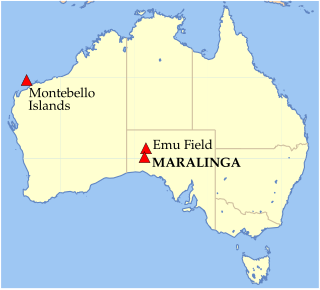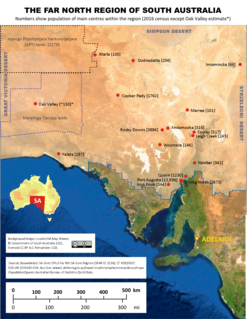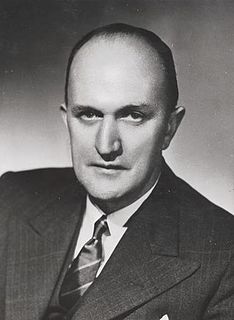Related Research Articles

Maralinga, in the remote western areas of South Australia, was the site, measuring about 3,300 square kilometres (1,300 sq mi) in area, of British nuclear tests in the mid-1950s.

Between 1956 and 1963, the United Kingdom conducted seven nuclear tests at the Maralinga site in South Australia, part of the Woomera Prohibited Area about 800 kilometres (500 mi) north west of Adelaide. Two major test series were conducted: Operation Buffalo in 1956 and Operation Antler the following year. Approximate weapon yields ranged from 1 to 27 kilotons of TNT. During the same period, the Maralinga site was also used for minor trials, tests of nuclear weapons components not involving nuclear explosions. Kittens were trials of neutron initiators; Rats and Tims measured how the fissile core of a nuclear weapon was compressed by the high explosive shock wave; and Vixens investigated the effects of fire or non-nuclear explosions on atomic weapons. The minor trials, numbering around 550, ultimately generated far more contamination than the major tests.

The Pitjantjatjara are an Aboriginal people of the Central Australian desert near Uluru. They are closely related to the Yankunytjatjara and Ngaanyatjarra and their languages are, to a large extent, mutually intelligible.

The Pila Nguru, often referred to in English as the Spinifex people, are an Aboriginal Australian people of Western Australia, whose lands extend to the border with South Australia and to the north of the Nullarbor Plain. The centre of their homeland is in the Great Victoria Desert, at Tjuntjunjarra, some 700 kilometres (430 mi) east of Kalgoorlie, perhaps the remotest community in Australia. The Pila Nguru were the last Australian people to have dropped the complete trappings of their traditional lifestyle.

Mamungari Conservation Park is a protected area located in South Australia within the southern Great Victoria Desert and northern Nullarbor Plain about 200 kilometres west of Maralinga and 450 kilometres northwest of Ceduna. It is about 1,000 kilometres (620 mi) north-west of Adelaide and abuts the Western Australia border

Oak Valley is the only community of Maralinga Tjarutja Aboriginal Council (AC) Local Government Area (LGA), South Australia. The population fluctuates, but a 2016 survey reported around 128 people, mostly Aboriginal. It is approximately 128 kilometres (80 mi) NNW of the original Maralinga township, and lies at the southern edge of the Great Victoria Desert. It is named for the desert oaks that populate the vicinity of the community.

The Maralinga Tjarutja, or Maralinga Tjarutja Council, is the corporation representing the traditional Anangu owners of the remote western areas of South Australia known as the Maralinga Tjarutja lands. The council was established by the Maralinga Tjarutja Land Rights Act 1984. The area is one of the four regions of South Australia classified as an Aboriginal Council (AC) and not incorporated within a local government area.

Larissa Yasmin Behrendt is a legal academic, writer, filmmaker and Indigenous rights advocate. As of 2020 she is a Professor of Law and Director of Research and Academic Programs at the Jumbunna Institute for Indigenous Education and Research at the University of Technology Sydney, and holds the inaugural Chair in Indigenous Research.

The Far North is a large region of South Australia close to the Northern Territory border. Colloquial usage of the term in South Australia refers to that part of South Australia north of a line roughly from Ceduna through Port Augusta to Broken Hill. The South Australian Government defines the Far North region similarly with the exception of the Maralinga Tjarutja Lands. the Yalata Aboriginal community and other unincorporated crown lands in the state's far west, which are officially considered part of the Eyre and Western region.
The McClelland Royal Commission or Royal Commission into British nuclear tests in Australia was an inquiry by the Australian government in 1984–1985 to investigate the conduct of the British in its use, with the then Australian government's permission, of Australian territory and soldiers for testing nuclear weapons. It was chaired by Jim McClelland.

Yalata is an Aboriginal community located 200 kilometres (120 mi) west of Ceduna on the Great Australian Bight in South Australia. At the 2016 census, Yalata and the surrounding area had a population of 248.

James Yami Lester was a Yankunytjatjara man, an Indigenous person of northern South Australia. Lester, who survived nuclear testing in outback Australia, is best known as an anti-nuclear and indigenous rights advocate.

Sir Oliver Howard Beale KBE was an Australian politician and diplomat. He was a member of the Liberal Party and served in the House of Representatives from 1946 to 1958, representing the New South Wales seat of Parramatta. He held ministerial office in the Menzies Government as Minister for Information (1949–1950), Transport (1949–1950), Supply (1950–1958), and Defence Production (1956–1958). He retired from parliament to serve as Australian Ambassador to the United States (1958–1964). His son Julian also entered politics.

Rear Admiral Kevin John Scarce, is a retired Royal Australian Navy officer who was the 34th Governor of South Australia, serving from August 2007 to August 2014. He was succeeded by Hieu Van Le, who had previously been his lieutenant governor. He was Chancellor of the University of Adelaide from 2014 to 2020.

The United Kingdom conducted 12 major nuclear weapons tests in Australia between 1952 and 1957. These explosions occurred at the Montebello Islands, Emu Field and Maralinga.
Ngapartji Ngapartji was a community development and Indigenous language maintenance/revitalisation project produced by the Australian arts and social change company Big hART conducted in various locations across the Anangu, Pitjantjatjara and Yankunytjatjara (APY) Lands in Central Australia and in Alice Springs. The project ran from 2005 to 2010 with spin-off projects and related performances. The project was structured around an experimental and reflexive arts-based community development program which included the creation of an online interactive language and culture learning website by Pitjantjatjara-speaking young people, elders and linguists; a bilingual touring theatre work and a media campaign promoting the development of an Australian national Indigenous language policy.

The Maralinga to Emu Road is a remote unsealed outback track that links Maralinga to Emu in the western region of South Australia. It was built by Len Beadell for the Weapons Research Establishment of Salisbury, South Australia in 1955.

The Vokes Hill Corner to Cook Road is a remote unsealed outback track that links Vokes Hill Corner on the Anne Beadell Highway to Cook on the Trans-Australian Railway in the far west of South Australia. It was built by Len Beadell for the Australian Government's Weapons Research Establishment in late 1961.
Yhonnie Scarce is an Australian glass artist whose work is held in major Australian galleries. She is a descendant of the Kokatha and Nukunu people of South Australia, and her art is informed by the effects of colonisation on Indigenous Australia, in particular Aboriginal South Australians. She has been active as an artist since completing her first degree in 2003, and teaches at the Centre of Visual Art in the Victorian College of the Arts in Melbourne.
Winnie Bamara (1939-?) was the first Indigenous Australian woman artist to paint in a European realist style. Her ability to paint scenes accurately and solely from memory attracted wide attention in the 1950s. She was hailed as a "female Albert Namatjira".
References
- 1 2 the exact date is unknown
- 1 2 Barton Railway Siding
- 1 2 3 4 5 6 7 8 Mark McGinness, (3 December 2008), Hero of the Maralinga people: Archie Barton 1936–2008, The Sydney Morning Herald, Sydney, p. 20
- 1 2 3 4 5 6 7 8 Kathy Marks, (7 November 2008), Archie Barton: Aboriginal leader who campaigned for the clean-up of the Maralinga nuclear test sites, The Independent, London
- 1 2 Sandra McKay, (20 December 1997), The dispossessed, The Age, Melbourne, p. 4